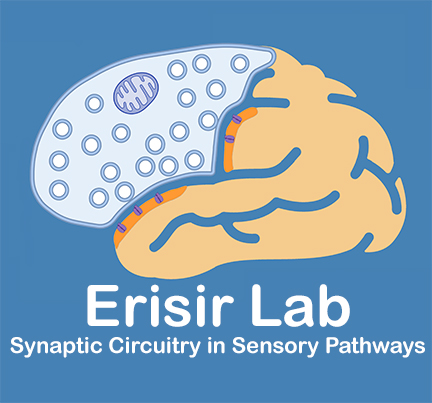Publications
2024
We seek to develop techniques for high-resolution imaging of the tree shrew retina for visualizing and parameterizing retinal ganglion cell (RGC) axon bundles in vivo. We applied visible-light optical coherence tomography fibergraphy (vis-OCTF) and temporal speckle averaging (TSA) to visualize individual RGC axon bundles in the tree shrew retina. For the first time, we quantified individual RGC bundle width, height, and cross-sectional area and applied vis-OCT angiography (vis-OCTA) to visualize the retinal microvasculature in tree shrews. Throughout the retina, as the distance from the optic nerve head (ONH) increased from 0.5 mm to 2.5 mm, bundle width increased by 30%, height decreased by 67%, and cross-sectional area decreased by 36%. We also showed that axon bundles become vertically elongated as they converge toward the ONH. Ex vivo confocal microscopy of retinal flat-mounts immunostained with Tuj1 confirmed our in vivo vis-OCTF findings.
2023
The thalamus is the main gateway for sensory information from the periphery to the mammalian cerebral cortex. A major conundrum has been the discrepancy between the thalamus's central role as the primary feedforward projection system into the neocortex and the sparseness of thalamocortical synapses. Here we use new methods, combining genetic tools and scalable tissue expansion microscopy for whole-cell synaptic mapping, revealing the number, density and size of thalamic versus cortical excitatory synapses onto individual layer 2/3 (L2/3) pyramidal cells (PCs) of the mouse primary visual cortex. We find that thalamic inputs are not only sparse, but remarkably heterogeneous in number and density across individual dendrites and neurons. Most surprising, despite their sparseness, thalamic synapses onto L2/3 PCs are smaller than their cortical counterparts. Incorporating these findings into fine-scale, anatomically faithful biophysical models of L2/3 PCs reveals how individual neurons with sparse and weak thalamocortical synapses, embedded in small heterogeneous neuronal ensembles, may reliably 'read out' visually driven thalamic input.
INTRODUCTION: The visual signals evoked at the retinal ganglion cells are modified and modulated by various synaptic inputs that impinge on lateral geniculate nucleus cells before they are sent to the cortex. The selectivity of geniculate inputs for clustering or forming microcircuits on discrete dendritic segments of geniculate cell types may provide the structural basis for network properties of the geniculate circuitry and differential signal processing through the parallel pathways of vision. In our study, we aimed to reveal the patterns of input selectivity on morphologically discernable relay cell types and interneurons in the mouse lateral geniculate nucleus.
METHODS: We used two sets of Scanning Blockface Electron Microscopy (SBEM) image stacks and Reconstruct software to manually reconstruct of terminal boutons and dendrite segments. First, using an unbiased terminal sampling (UTS) approach and statistical modeling, we identified the criteria for volume-based sorting of geniculate boutons into their putative origins. Geniculate terminal boutons that were sorted in retinal and non-retinal categories based on previously described mitochondrial morphology, could further be sorted into multiple subpopulations based on their bouton volume distributions. Terminals deemed non-retinal based on the morphological criteria consisted of five distinct subpopulations, including small-sized putative corticothalamic and cholinergic boutons, two medium-sized putative GABAergic inputs, and a large-sized bouton type that contains dark mitochondria. Retinal terminals also consisted of four distinct subpopulations. The cutoff criteria for these subpopulations were then applied to datasets of terminals that synapse on reconstructed dendrite segments of relay cells or interneurons.
RESULTS: Using a network analysis approach, we found an almost complete segregation of retinal and cortical terminals on putative X-type cell dendrite segments characterized by grape-like appendages and triads. On these cells, interneuron appendages intermingle with retinal and other medium size terminals to form triads within glomeruli. In contrast, a second, presumed Y-type cell displayed dendrodendritic puncta adherentia and received all terminal types without a selectivity for synapse location; these were not engaged in triads. Furthermore, the contribution of retinal and cortical synapses received by X-, Y- and interneuron dendrites differed such that over 60% of inputs to interneuron dendrites were from the retina, as opposed to 20% and 7% to X- and Y-type cells, respectively.
CONCLUSION: The results underlie differences in network properties of synaptic inputs from distinct origins on geniculate cell types.
